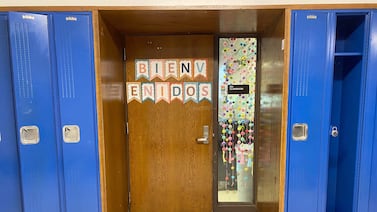Illinois students are still struggling to get back to pre-COVID academic achievement levels in math and reading, according to the state’s latest school report card, which mirrors national trends showing sharp declines in test scores following pandemic disruptions.
Preliminary results released today from the 2022 Illinois Assessment of Readiness, known as the IAR, show that 29.9% of students between third grade and eighth grade met or exceeded state standards in reading, a 7.5 percentage point drop from 2019. In math, 25.8% of students in those grades met or exceeded state standards, a 6.2 percentage point decline from 2019.
The state board of education says 20% fewer Illinois students met or exceeded grade level standards in reading and math in 2022 compared to 2019, before the pandemic shuttered schools and upended learning. State officials say they anticipated the drop because it aligns with nationwide trends.
Testing conditions for the 2022 spring assessments were more typical than in 2021, when virtual learning was still in place for many Illinois schools and districts had the option to administer the state test in the spring or fall. Low participation rates for Black and Hispanic students in 2021 also make comparisons to that year problematic.
While the 2022 results show declines in proficiency levels, the state did see gains on other metrics, including an increase in the four-year graduation rate, which reached its highest level in the past 12 years. The number of ninth graders on track to graduate also held steady and the number of students who need remedial classes when they go to community college dropped. Enrollment also went back to its previous trend of decreasing by only 1% per year.
In a press release, State Superintendent Carmen Ayala said the 2022 report card data shows that the state is on the right track despite the challenges posed by the pandemic.
“The accelerated rate of learning that students achieved last year means that we’re headed in the right direction,” said Ayala. “The ways in which we invested the federal pandemic relief funds are working. We can expect to see even more growth over the next couple years as these programs expand and reach even more students.”
Still, the latest report card indicates that the state’s 2 million students continue to grapple with the effects of the pandemic, which led to statewide school closures. Illinois students had limited options for in-person learning until 2021-2022, when the state mandated that all schools reopen classrooms. Students with disabilities often did not have access to vital services or paraprofessionals in remote learning.
The state also struggled with getting students to attend schools in 2022. Chronic absenteeism — when students miss school 10% of the school year, or 18 to 20 days, with or without a valid excuse — rose to almost 30% compared to 17.5% in 2019. The rates for chronic absenteeism were higher among Black and Hispanic students, English learners, students from low-income families, and students with disabilities.
In Chicago, 20.1% of students were proficient in reading and 15.7% in math on the 2022 IAR — a decline of 6.9 percentage points from 2019 in reading and 8.1 percentage points in math.
The 2022 results also show that the proficiency levels of Illinois students in third grade — the first year students start to take state and national exams — are still below pre-pandemic levels in both math and reading on the IAR, the annual spring exam administered to Illinois students between third and eighth grade.
About 27.4% of the state’s third graders met or exceeded the state’s standards in reading — 9 percentage points lower than the 2019 scores in that subject. In math, 33.8% of third graders met or exceeded state standards — 6.8 percentage points lower than in 2019.
On the SAT — a standardized exam used by many colleges as part of admission criteria — 29.8% of the state’s 11th graders were proficient in reading while 28.8% were proficient in math in 2022, a drop of almost 7 percentage points in reading and 6 percentage points in math from 2019.
Among Chicago’s 11th graders, 21% were proficient in reading and 20.5% in math on the SAT, dropping 5.3 percentage points in reading and 6.2 percentage points in math from 2019.
Racial and other disparities on state tests persist
The 2022 state report card also shows continuing disparities among racial and ethnic groups, English language learners, and students with Individualized Education Programs (IEPs), according to a Chalkbeat analysis.
On the IAR and SAT, Asian American and white students far outpaced their Black and Hispanic peers, who were among the hardest hit by the pandemic.
The 2022 data shows that, on the IAR, only 6.9% of the state’s English language learners were proficient in reading and 6.8% were proficient in math. English language learners make up over 13% of the student population.
Among students with IEPs, who make up 16.5% of the state’s student population, only 7% were proficient in English language arts and 7.2% in math. During virtual learning, many students with IEPs were cut off from vital services such as occupational and speech-language services and from the support of paraprofessionals.
Chicago has created a recovery plan for students with disabilities. However, shortages of special education teachers and paraprofessionals present obstacles in helping students with disabilities get back on track.
During Chicago’s school board meeting on Wednesday, district CEO Pedro Martinez acknowledged “significant drops in proficiency in math and reading” in both NAEP and state tests results. The declines are consistent with results from other school districts across the country, he said.
“This is data that is very sobering,” Martinez said, calling it “a reflection of the pandemic,” not of students’ abilities or the hard work of faculty.
Despite the challenges, Martinez expressed optimism that the current school year would bring a strong recovery.
Illinois scores reflect national trends
The Illinois scores reflect challenges facing schools around the country as they grapple with the academic fallout from the pandemic. Data from the National Assessment of Educational Progress, or NAEP, found that test scores for students in fourth and eighth grades saw unprecedented declines in math and dips in reading between 2019 and 2022.
Chicago’s latest NAEP scores saw math proficiency levels return to what they were almost a decade ago, while reading scores had a slight dip. Illinois’s NAEP scores remained flat between 2019 and 2022 for fourth graders in both reading and math while eighth graders saw a dip in math.
State officials say that there is still work to be done to get students back on track and have already started to use emergency funding to provide academic support to students.
Illinois received $7.8 billion in federal COVID relief funds, distributing 90% of the money to local school districts through Title I and keeping 9.5%, or almost $500 million, for state initiatives.
About $25 million of the state’s pot of federal funds went to create the Illinois Tutoring Initiative to help students in underserved school districts receive free high-impact tutoring. The state also provided 455 of Illinois’ 852 school districts digital equity grants to provide technology such as computers and iPads to close the digital divide. Almost 130 districts offered Jump Start programs to provide educational support to incoming kindergarteners and first grade students.
Mauricio Peña contributed to this report.
Samantha Smylie is the state education reporter for Chalkbeat Chicago, covering school districts across the state, legislation, special education, and the state board of education. Contact Samantha at ssmylie@chalkbeat.org.








